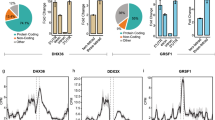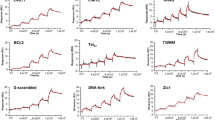Abstract
Guanine-rich nucleic acid sequences can adopt noncanonical four-stranded secondary structures called guanine (G)-quadruplexes1. Bioinformatics analysis suggests that G-quadruplex motifs are prevalent in genomes2, which raises the need to elucidate their function. There is now evidence for the existence of DNA G-quadruplexes at telomeres with associated biological function3. A recent hypothesis supports the notion that gene promoter elements contain DNA G-quadruplex motifs that control gene expression at the transcriptional level4. We discovered a highly conserved, thermodynamically stable RNA G-quadruplex in the 5′ untranslated region (UTR) of the gene transcript of the human NRAS proto-oncogene. Using a cell-free translation system coupled to a reporter gene assay, we have demonstrated that this NRAS RNA G-quadruplex modulates translation. This is the first example of translational repression by an RNA G-quadruplex. Bioinformatics analysis has revealed 2,922 other 5′ UTR RNA G-quadruplex elements in the human genome. We propose that RNA G-quadruplexes in the 5′ UTR modulate gene expression at the translational level.
This is a preview of subscription content, access via your institution
Access options
Subscribe to this journal
Receive 12 print issues and online access
$259.00 per year
only $21.58 per issue
Buy this article
- Purchase on Springer Link
- Instant access to full article PDF
Prices may be subject to local taxes which are calculated during checkout


Similar content being viewed by others
References
Neidle, S. & Balasubramanian, S. Quadruplex Nucleic Acids (RSC Biomolecular Sciences, Cambridge, 2006).
Huppert, J.L. & Balasubramanian, S. Prevelance of quadruplexes in the human genome. Nucleic Acids Res. 33, 2908–2916 (2005).
Paeschke, K., Simonsson, T., Postberg, J., Rhodes, D. & Lipps, H.J. Telomere end-binding proteins control the formation of G-quadruplex DNA structures in vivo. Nat. Struct. Mol. Biol. 12, 847–854 (2005).
Siddiqui-Jain, A., Grand, C.L., Bearss, D.J. & Hurley, L.H. Direct evidence for a G-quadruplex in a promoter region and its targeting with a small molecule to repress c-MYC transcription. Proc. Natl. Acad. Sci. USA 99, 11593–11598 (2002).
Saccà, B., Lacroix, L. & Mergny, J.-L. The effect of chemical modifications on the thermal stability of different G-quadruplex-forming oligonucleotides. Nucleic Acids Res. 33, 1182–1192 (2005).
Willis, A.E. Translational control of growth factor and proto-oncogene expression. Int. J. Biochem. Cell Biol. 31, 73–86 (1999).
Downward, J. Targeting Ras signalling pathways in cancer therapy. Nat. Rev. Cancer 3, 11–22 (2003).
Barbacid, M. Ras genes. Annu. Rev. Biochem. 56, 779–827 (1987).
Eskandarpour, M. et al. Suppression of oncogenic NRAS by RNA interference induces apoptosis of human melanoma cells. Int. J. Cancer 115, 65–73 (2005).
Hall, A. & Brown, R. Human N-ras: cDNA cloning and gene structure. Nucleic Acids Res. 13, 5255–5268 (1985).
Balagurumoorthy, P., Brahmachari, S.K., Mohanty, D., Bansal, M. & Sasisekharan, V. Hairpin and parallel quartet structure for telomeric sequences. Nucleic Acids Res. 20, 4061–4067 (1992).
Tang, C.-F. & Shafer, R.H. Engineering the quadruplex fold: nucleoside conformation determines both folding topology and molecularity in guanine quadruplexes. J. Am. Chem. Soc. 128, 5966–5973 (2006).
Mergny, J.-L., Phan, A.-T. & Lacroix, L. Following G-quartet formation by UV-spectroscopy. FEBS Lett. 435, 74–78 (1998).
Hardin, C.C., Watson, T., Corregan, M. & Bailey, C. Cation-dependent transition between the quadruplex and Watson-Crick hairpin forms of d(CGCG3GCG). Biochemistry 31, 833–841 (1992).
DiLella, A.G. et al. Utility of firefly luciferase as a reporter gene for promoter activity in transgenic mice. Nucleic Acids Res. 16, 4159 (1988).
Kozak, M. Structural features in eukaryotic mRNAs that modulate the initiation of translation. J. Biol. Chem. 266, 19867–19870 (1991).
Searle, M.S. & Balkwill, G.D. in Quadruplex Nucleic Acids (eds. Neidle, S. & Balasubramanian, S.) 131–153 (RSC Biomolecular Sciences, Cambridge, 2006).
Neidle, S. & Parkinson, G. Telomere maintenance as a target for anticancer drug discovery. Nat. Rev. Drug Discov. 1, 383–393 (2002).
Mergny, J.L. & Lacroix, L. Analysis of thermal melting curves. Oligonucleotides 13, 515–537 (2003).
Acknowledgements
We thank Cancer Research UK, the Cambridge Commonwealth Trust and Trinity College, Cambridge for funding. S.B. is a Biotechnology and Biological Sciences Research Council career development fellow. J.L.H. is a research fellow at Trinity College, Cambridge. We thank Z. Jawad-Alami for useful discussions and S. Sewitz for critically reading this manuscript.
Author information
Authors and Affiliations
Contributions
S.K., A.B. and S.B. conceived and designed the experiments. S.K. performed all the experiments. S.K. and A.B. analyzed the experimental data. J.L.H. conceived, designed and carried out the bioinformatics studies. All four authors discussed the results, and the manuscript was written by S.K. and S.B. with contributions from A.B. and J.L.H.
Corresponding author
Ethics declarations
Competing interests
The authors declare no competing financial interests.
Supplementary information
Supplementary Fig. 1
cDNA sequence of NRAS 5′ UTR. (PDF 98 kb)
Supplementary Fig. 2
CD melting of NRQ RNA G quadruplex. (PDF 37 kb)
Supplementary Table 1
Second G-quadruplex sequence motif in the NRAS 5′ UTRs of mouse and dog. (PDF 66 kb)
Supplementary Table 2
UV-melting temperatures of NRQ RNA G quadruplex at various strand concentrations. (PDF 18 kb)
Supplementary Table 3
UV-melting temperatures of NRQ RNA G quadruplex with different monovalent cations. (PDF 19 kb)
Rights and permissions
About this article
Cite this article
Kumari, S., Bugaut, A., Huppert, J. et al. An RNA G-quadruplex in the 5′ UTR of the NRAS proto-oncogene modulates translation. Nat Chem Biol 3, 218–221 (2007). https://doi.org/10.1038/nchembio864
Received:
Accepted:
Published:
Issue Date:
DOI: https://doi.org/10.1038/nchembio864
This article is cited by
-
G-quadruplexes in MTOR and induction of autophagy
Scientific Reports (2024)
-
G-quadruplex structural dynamics at MAPK12 promoter dictates transcriptional switch to determine stemness in breast cancer
Cellular and Molecular Life Sciences (2024)
-
Crosstalk between G-quadruplex and ROS
Cell Death & Disease (2023)
-
Tandem repeats ubiquitously flank and contribute to translation initiation sites
BMC Genomic Data (2022)



